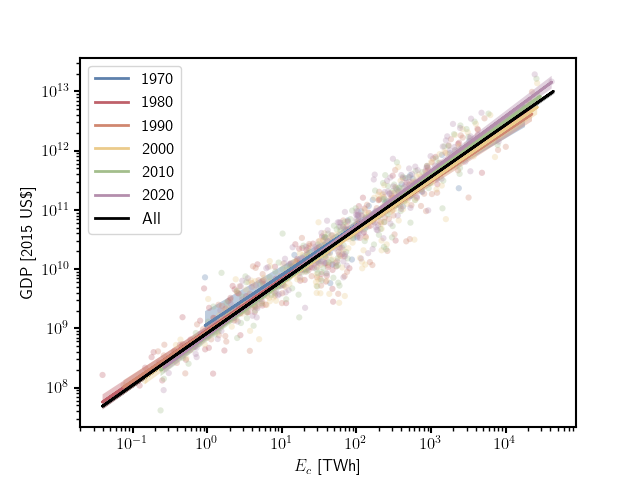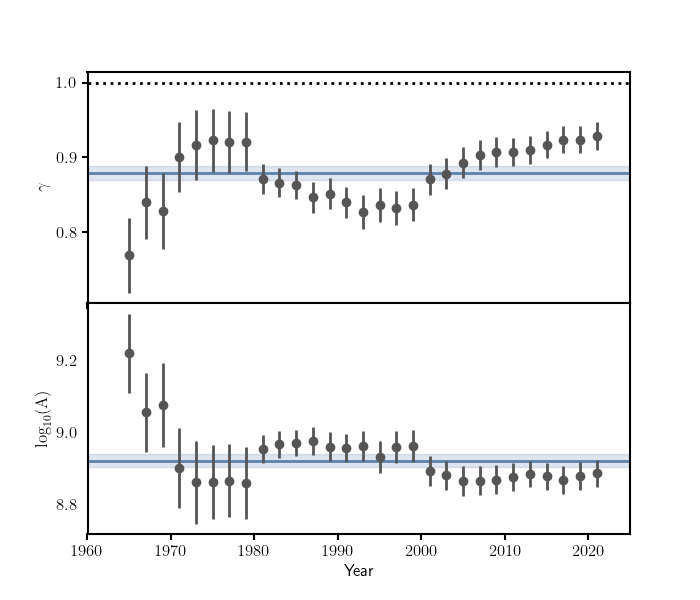In its 2023 synthesis report, the Intergovernmental Panel on Climate Change (IPCC) restated that human activities "have unequivocally caused global warming'' mostly due to greenhouse gas (GHG) emissions resulting from "unsustainable energy use, land use and land use change, lifestyles and patterns of consumption and production''. In the same report, the IPCC states the importance of reducing GHG emissions and highlights possible pathways to contain global warming within {1.5}^\circ C or {2}^\circ C in accordance with Paris Agreement adopted at the 2015 United Nations Climate Change Conference.
Concurrently the Intergovernmental Science-Policy Platform on Biodiversity and Ecosystem Services (IPBES) reported in their 2019 global assessment report that "human actions threaten more species with global extinction now than ever before'', estimating that 25% of species are threatened. The IPBES identifies 5 main direct drivers of global change in nature over the past 50 years: changes in land and sea use, direct exploitation of organisms, climate change, pollution, and invasion of alien species; all of them tied to human activities.
There have been growing discussions among geologists over the past decades that we might have left the geological epoch of the Holocene, to enter a new epoch coined Anthropocene after the Greek word anthropos (human, mankind), signifying that human activities are now the main driver of change of the global environment.
An international collaboration led by the Stockholm Resilience Center introduced the concept of planetary boundaries. This framework is an attempt at assessing the risk that human activities destabilize the Earth system which could lead to abrupt global environmental change. Planetary boundaries are not thresholds in the sense that crossing one or more of the planetary boundaries doesn't result in an immediate change to the Earth system. However, they define a safe operating space, within which, according to the current scientific knowledge, there is a very limited risk of perturbation of the Earth system. In 2015 it was estimated that out of the 9 planetary boundaries identified, 2 had been crossed and 2 were in a zone of uncertainty (corresponding to increasing risks). The most recent study estimates that as of 2023, 6 planetary boundaries have been crossed, climate change and biodiversity integrity being only two of them. Other direct threats to life on Earth include the perturbation of biogeochemical flows, land-system change, freshwater change and the introduction of novel entities (pollution).
It follows that our response to the global ecological catastrophe cannot be solely targeted to climate change through the diminution of GHG emissions. This approach would leave all other threats unaddressed and, above all, miss the systemic aspect of the situation that was already understood and explained in the 1972 report to the Club of Rome, The Limits to Growth.
All of the threats listed above result from the voluntary or involuntary transformation of the Earth system by human activities. Voluntary transformations can take many forms, such as agriculture-driven deforestation, urbanization, mining for fossil energy and ores, the transformation of these ores by and for the different industries (including the production of batteries, solar panels, windmills) and much more. All of the forementioned voluntary transformations are always associated with involuntary transformations such as the destruction of natural habitats or the pollution of air, soil and water.
The physical property that quantifies one's ability to transform its environment is energy. Without energy, no transformation can physically happen. It is therefore not surprising that the link between economies and energy use is a long-standing question. Yet most studies focus on determining the energy efficiency of economies at the country or sub-country level, or on the question of causality between energy consumption and GDP growth. It is common in these studies to work with quantities normalized per capita (energy consumption per capita, GDP per capita). While this normalization is useful to compare the efficiency of different economies from different countries, it is not well suited to study the impact of the global economy on the Earth system as the latter responds to absolute transformations, not transformations per capita.
Here I study the relationship between the primary energy consumption of countries and their gross domestic products. I work with absolute quantities at the global scale, because these quantities and scale give a clear picture of the link between energy consumption and GDP that is sometimes overlooked, as seen in this interview of former managing director of the World Bank Group, Bertrand Badré (in French):
Today money is representative of a certain type of richness, but has no immediate link to natural ressources, petroleum, copper, solar energy, or I don't know what. [sic]
Bertrand Badré, former Managing Director and World Bank Group Chief Financial Officer, on Thinkerview 2024
The Energy - GDP relationship
So let's study the relationship between the primary energy consumption (E_c) and the Gross Domestic Product (GDP) of countries. For the energy part, I use data from the U.S Energy Information Administration processed by the website Our World In Data providing primary energy consumption from 1965 to 2022. The energy dataset covers all commercially-traded fuels (coil, oil, gas), nuclear energy and modern renewables, but does not contain traditional biomass. Its coverage goes from 65 countries in 1965 to 217 countries and legal entities in 2021. Given my aim to analyze correlations between energy consumption and GDP, I acknowledge that using the final energy consumption would be better suited for my goal, however, there are no currently publicly and freely available global catalogs for final energy consumption per country and per year. As I only use primary energy consumption in this study, whenever I use the term energy alone I refer to primary energy consumption.
For the GDP I use data from the World Bank and The Organisation for Economic Co-operation and Development (OECD) preprocessed by Our World In Data providing GDP per country from 1960 to 2021. The GDP is expressed in constant 2015 US$. It covers 87 countries in 1960 up to 195 countries and legal entities in 2021.
After merging the two datasets I obtain the input dataset containing both primary energy consumption and GDP with a coverage ranging from 42 countries in 1965 to 189 countries in 2021. The figure below shows the log-log distribution of the GDP as a function of the primary energy consumption including all data available in the dataset. Each point corresponds to the GDP - energy relationship for a given country for a given year. As seen in the figure, there is a strong correlation between the GDP and energy consumption. The Pearson coefficient between the two variables is \rho_{E,GDP} = 0.914.
I model the GDP to energy relationship by a power-law defined as:
GDP = AE_c^{\gamma}where GDP is the GDP, E_c is the primary energy consumption, and A and \gamma are the two parameters of the model. Note that this simple model accounts for the physical limitation that there can be no GDP without energy consumption. Using ordinary least square regression in the log-log space, the model is able to correctly fit the data over seven orders of magnitudes in both energy and GDP. The estimated parameters and their respective standard errors are \rm{log}_{10}A=8.920\pm0.006 and \gamma=0.879\pm0.003. The value of A is the model estimate for the GDP of an economy that consumes 1TWh of primary energy, it is equal to about 0.83 billion US$ (constant 2015). The R-squared of the fit is R^2=0.915. The best fit is shown in the figure above as a black continuous line together with the [0.025, 0.975] confidence interval which is contained within the thickness of the best-fit line.
It is interesting to note that a \gamma value of 1 would be equivalent to a linear relationship between the GDP and the energy consumption. The fact that the best-fitted value of \gamma is below 1 means that bigger economies tend to be less energy efficient (producing less GDP per unit of energy) than smaller economies.
Of course, there is some variability in the data and some economies deviate from the model estimates. Deviations can result from different factors such as inaccuracy in data (e.g. neglecting the traditional biomass as a primary energy source has a significant impact on the estimate of the primary energy consumption of some countries, such as sub-saharan ones), border effects due to the globalization of the economy (e.g. when the energy used to produce some value is counted in one country, but the added economic value is at least partially accounted for in another country), or differences in the energy efficiency of the economies. I compute model residuals by subtracting the model estimates from the GDP measurements. The standard deviation of the residuals in log space is 0.29, meaning that most (74%) of the economies have a GDP within a factor of 2 of the model estimates. 99.7% of economies are within one order of magnitude of the model estimates.
To study the evolution in time of the GDP to energy relation let's produce similar figures for every year from 1965 to 2021. The figure below shows the resulting distributions for every tenth year. Once again, the simple power-law model is able to fit each distribution over seven orders of magnitudes.
The next figure shows the same data for every tenth year and corresponding regression models stacked over a single graph, showing that there is little evolution in the regression models.
The final figure below shows the best-fitted values of the parameters A and \gamma for every second year between 1965 and 2021. We see that the value of A, which corresponds to the average size of economies consuming 1TWh of primary energy per year, is stable over the years. The discontinuities in the values of A around the years 1980 and 2000 correspond to the addition of new countries to the the dataset on these dates. The parameter \gamma is increasing since the year 2000, getting closer to a value of 1 which would correspond to a linear relationship between the primary energy consumption and the GDP. Yet, as was mentioned previously, the fact that the value is lower than 1 even for recent years means that bigger economies tend to be on average less efficient in converting energy to GDP than smaller economies.
Conclusion
With human activities drastically impacting the Earth system and threatening the habitability of our planet, a good understanding of the link between the energy we consume and our economies is primordial. A lot of studies deal with this link, but they tend to focus on smaller scales (e.g. at the country or sub-country level) and look at normalized quantities (GDP per capita and energy per capita). The Earth System is not sensitive to normalized but to absolute quantities, thus we shouldn't forget the big picture.
Here we saw that a simple power-law model with 2 parameters is able to explain the relationship between the primary energy consumption of a country and its GDP. The model accurately describes the E_c-GDP relationship over 7 orders of magnitudes in both primary energy consumption and GDP. It also holds in time with only little variations between 1965 and 2021. Typical deviations from the model are contained within a factor of 2 in the size of the economy (1\sigma level) and only 0.2% of data points show deviations at more than one order of magnitude. The average size of an economy corresponding to a primary energy consumption of 1TWh is 0.83 billion US$ (constant 2015). Finally, bigger economies tend to be slightly less efficient in converting energy to GDP.
With no significant deviation neither in space nor time from the power-law model, this relation seems to be an attribute of the economy. In particular, there is no evidence for any form of decoupling between the primary energy consumption and the GDP at any scale that would be relevant for the Earth system.
Human activities are responsible for the current ecological crisis which includes but is not limited to climate change; Human activities are empowered by the consumption of primary energy; This primary energy consumption is strongly correlated to the size of our economies as measured by the GDP.
The source code of this analysis is available on gitlab.

![Gross domestic product as a function of the primary energy consumption. Every point represents a given country for a given year. The thick black line corresponds to the best fit for a two-parameters power-law model. The [0.025, 0.975] confidence interval for the best-fit is contained within the thickness of the best fit line. The diagonal grey lines show the expected slope for a linear model.](https://tdelubac.com/wp-content/uploads/2024/06/global_all_years.png)
![Similar to the first figure for every tenth year from 1970 do 2020. Every sub-figure only contains data points for the year displayed in the top left corner. The best fit of the power-law model for the corresponding year is shown as a black thick line, with the [0.025, 0.975] confidence interval visible as a grey area.](https://tdelubac.com/wp-content/uploads/2024/06/yearly.png)





